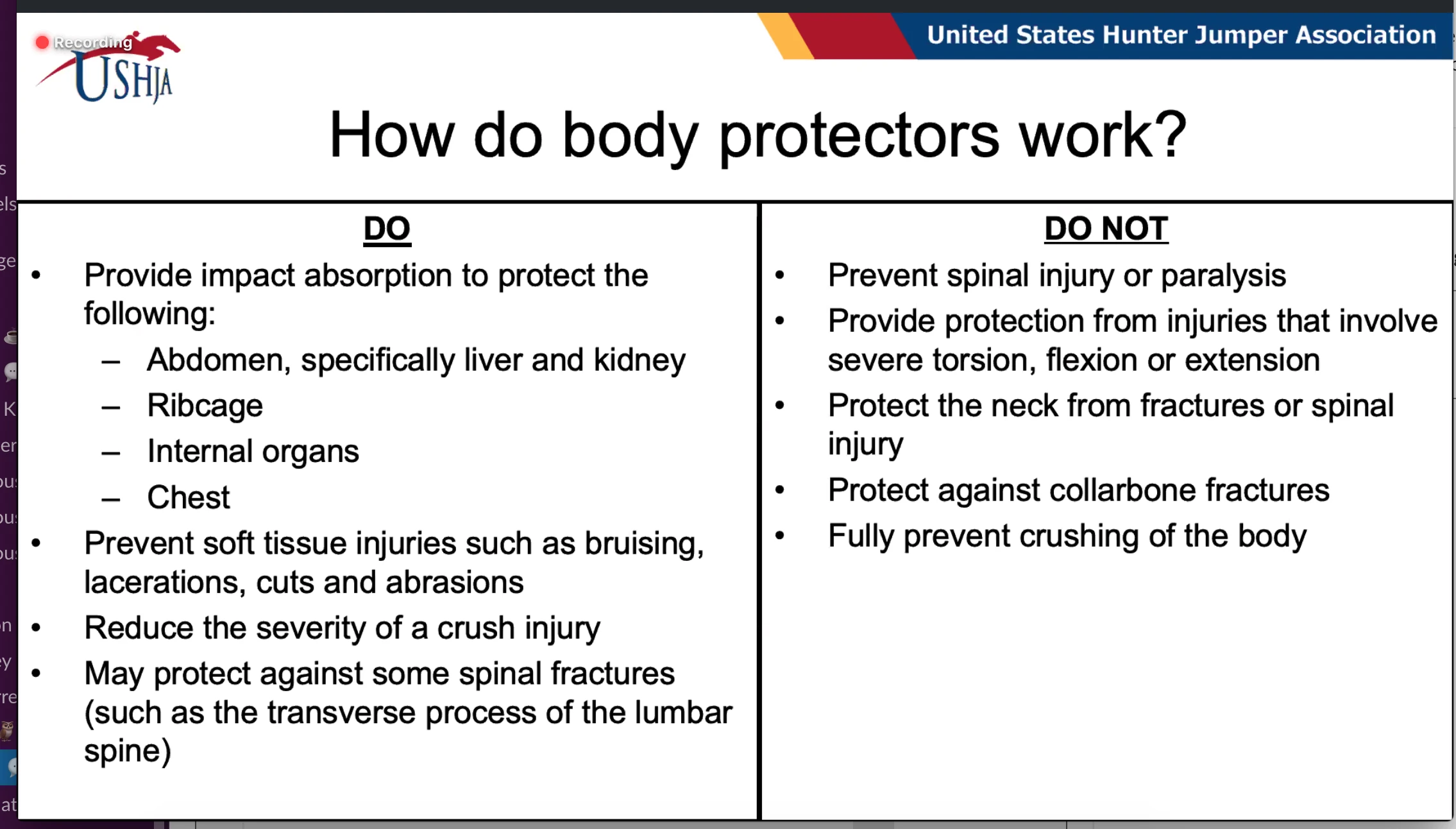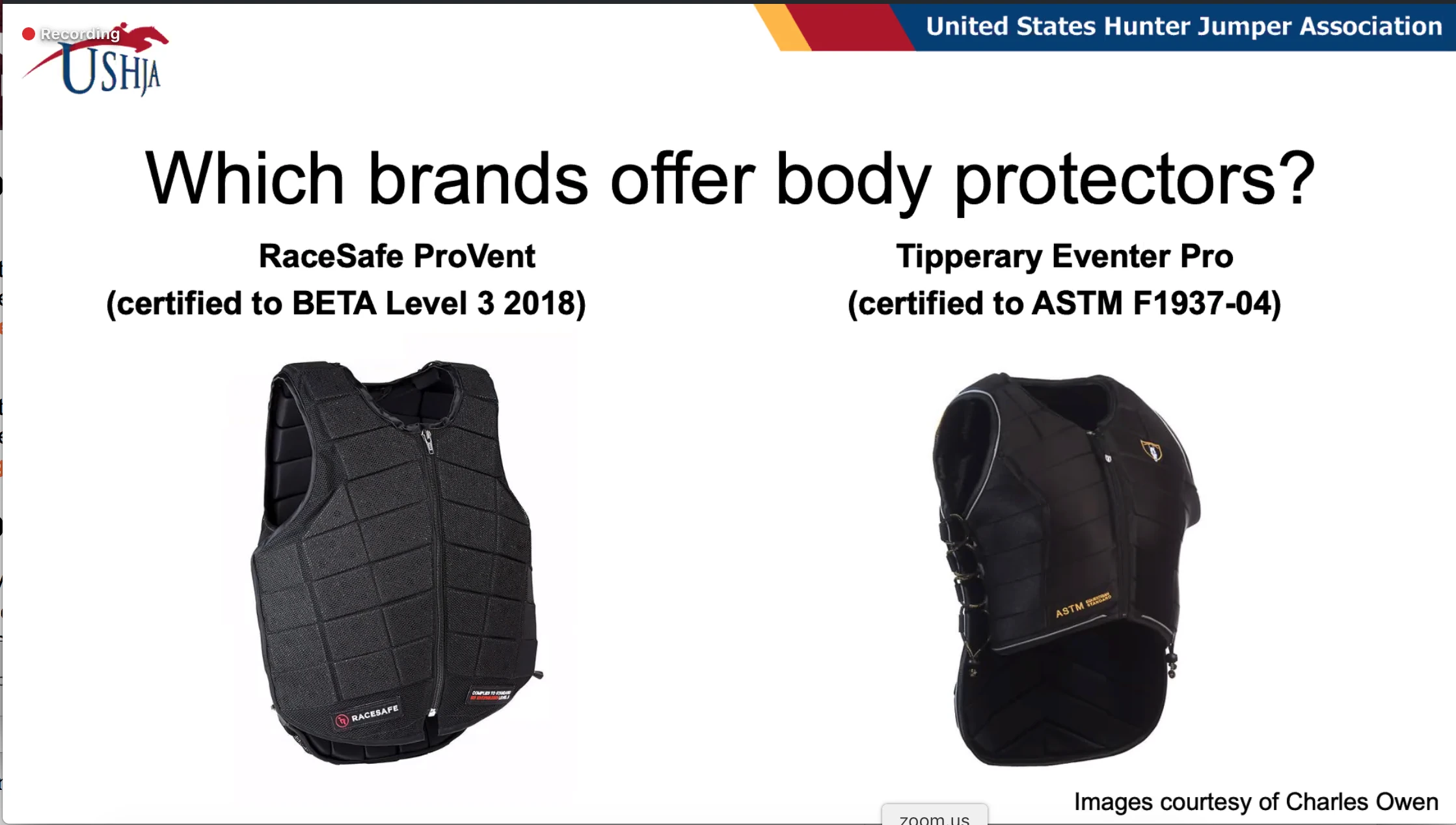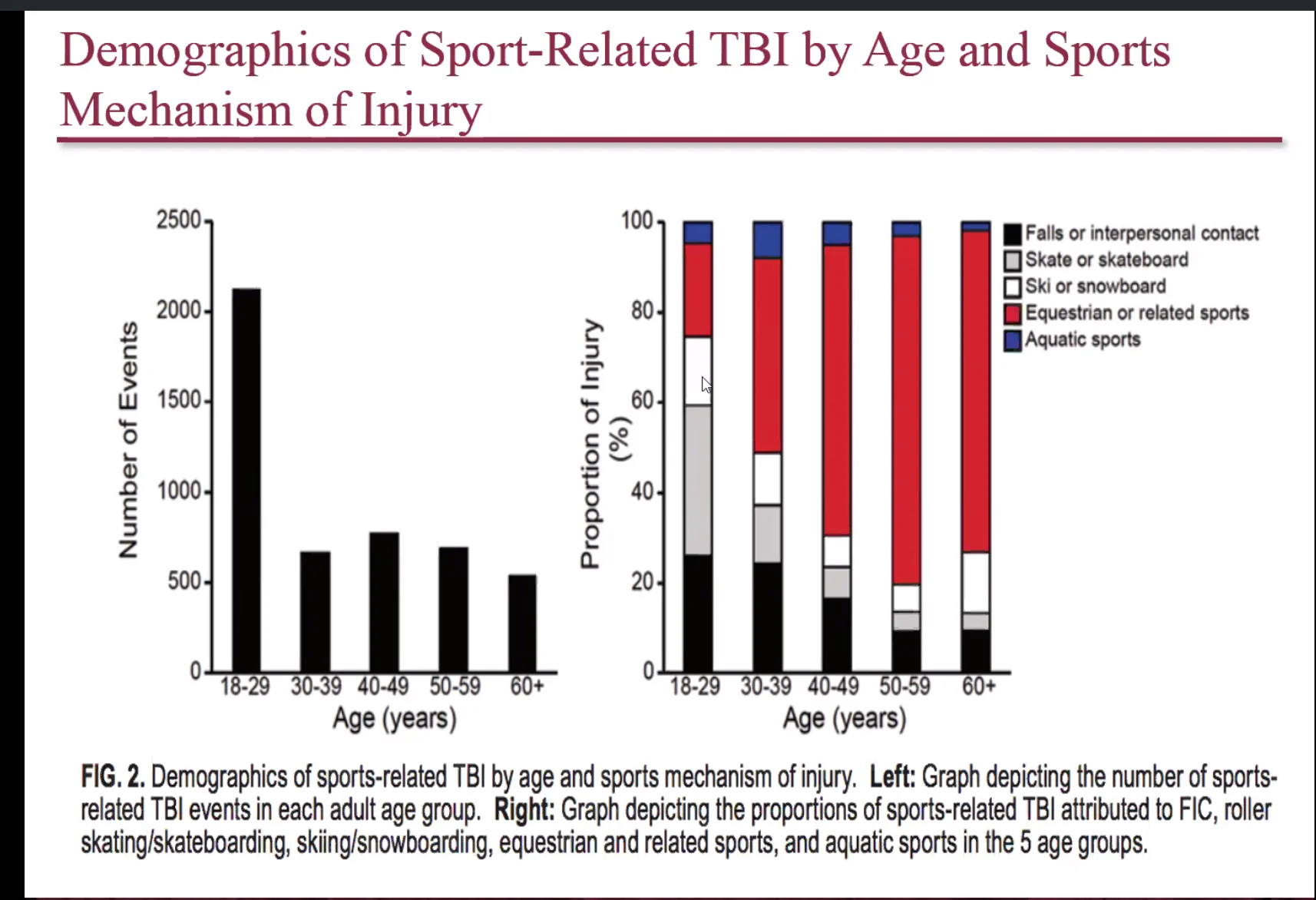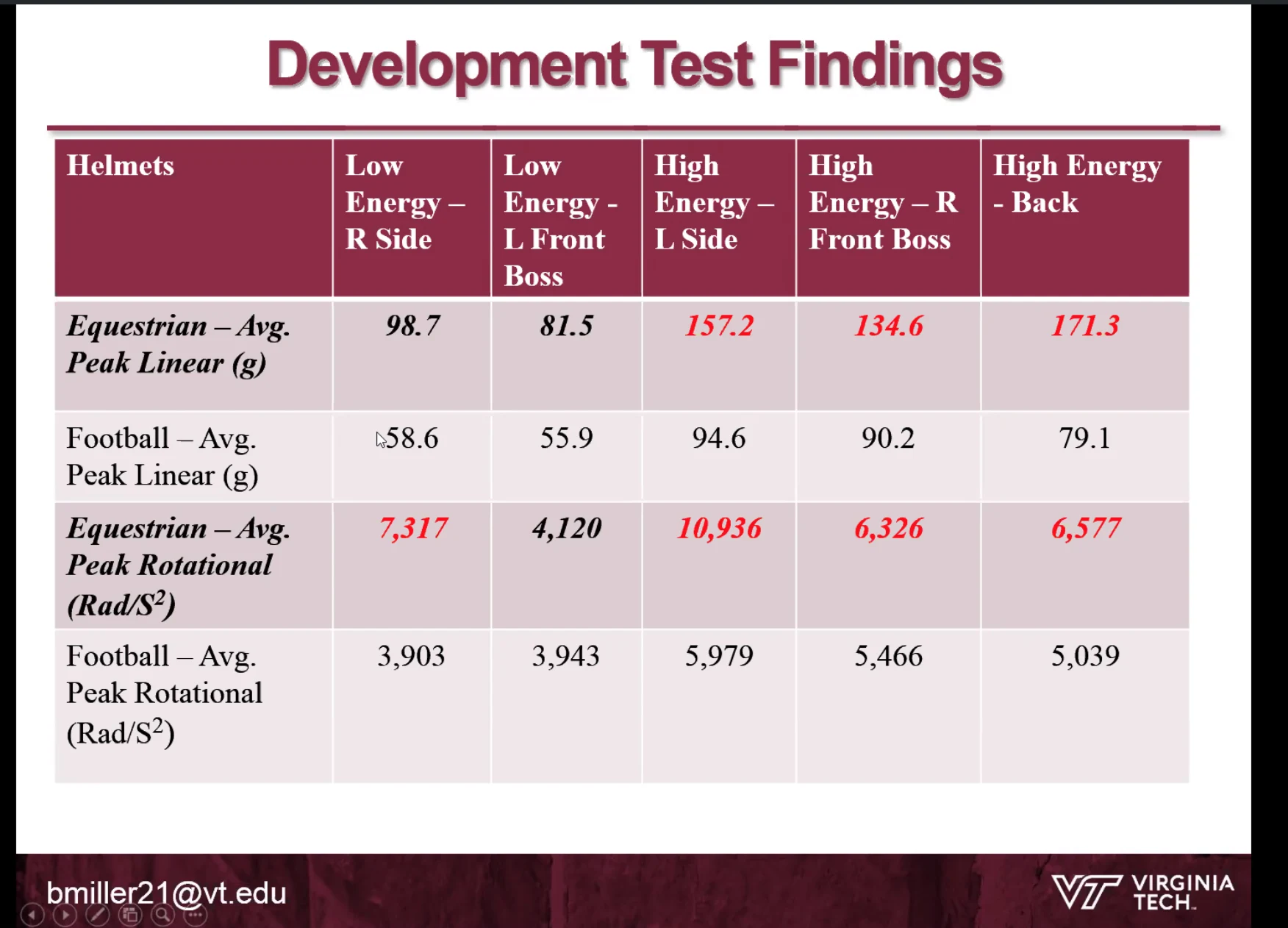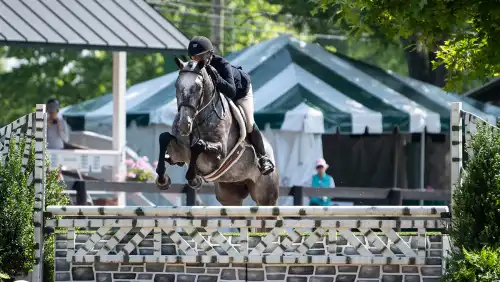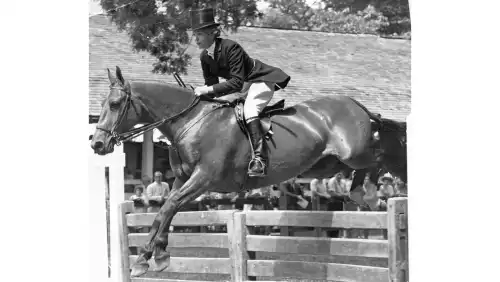The bad news is that one in five equestrians will suffer a serious injury at some point during their riding career. The good news? A lot of people, both in the industry and outside of it, are working to improve equestrian safety equipment to reduce the extent of those injuries.
Two informational sessions about equestrian safety equipment took place on Dec. 3 during the U.S. Hunter Jumper Association Annual Meeting, held online from Nov. 30-Dec. 11.
Danielle Santos from Charles Owen led a presentation on various types of body protectors, which have been gaining popularity at hunter/jumper shows, and Dr. Barry Miller presented information about the independent research happening at the Virginia Tech Helmet Lab. That program is about to begin testing equestrian helmets to give them a rating from 1-5 based on how well they protect heads against injury.
Here are 10 takeaways from their presentations.
1. Body protectors in the show ring are OK.
According to the “U.S. Equestrian Federation Rule Book,” GR 801.4, exhibitors may wear body protection in competition. In the last year or so more and more hunter/jumper competitors are donning the three types of body protectors outlined by Santos: traditional safety vests (Santos referred to these as “foundation garments”), air vests and shoulder protection, an add-on that can protect the collarbone.
Santos pointed out that body protectors reduce the severity of injuries but don’t eliminate them. See the chart below for what body protectors do and don’t help with.
2. Air vests aren’t certified for equestrian—yet—and they aren’t for everyone.
There is no certification standard for equestrian air vests.
“Certification for air technology is only based on motorcycles,” said Santos. “Obviously the falls are different. You will be slowed before you hit the ground, and you will have some protection from impact, but in the next couple of years, there will be a standard written for equestrian air vests.”
Air vests have a minimum weight limit in order to deploy properly, 55 pounds for a child and 84 pounds for an adult.
3. Air vest technology is moving quickly
ADVERTISEMENT
Air vests attach to the saddle via a lanyard and deploy when the rider separates from the saddle and the lanyard detaches. There is some research being done on new trigger mechanisms for air vests, and in the future there will be no lanyard.
“Gyroscopic air mechanisms are still in the research stage,” said Santos. “A sensor would look at whether the rider is still at the same plane. The trigger would release when it noticed you were no longer on that plane. If you were no longer vertical it would deploy. At the moment the research is being done with these mechanisms. But a product like this with a high level of innovation requires a lot of funding, and the equestrian industry doesn’t have that. It gets put onto universities to test the product. The research isn’t quite there yet because of lack of funding.”
4. Fit is important.
Santos suggested getting help fitting body protectors in a tack shop with an experienced professional or via video conferencing given COVID-19. She said traditional safety vests should go ¾ inch below your last rib in the front.
“That might feel a little shorter than the traditional Tipperary model that laces up the side, but it allows you to tuck and roll,” she said. “The back should not come below your tailbone. If it comes below the tailbone it will catch on the saddle on the back of a jump. It should cover important parts around the ribcage and chest.”
Fitting air vests can be a little trickier. As a newer item they don’t come in as wide a size range as air vests, and they come in a variety of shapes. Some come further down to help protect the hips and prevent torque to the lower spine, but those may not allow riders to tuck and roll away from the horse in case of a fall. Some come higher up to protect the neck.
5. Be prepared to pay for your safety.
According to Santos, several of the most popular traditional safety vests cost around $350, though the price can vary widely. The most popular air vests range from $615 to $950. After air vests inflate they require a new canister, which runs around $40-$50.
6. Research on equestrian helmets at the Virginia Tech Helmet Lab is set to begin.
A year ago Miller first entered the equestrian world thanks to safety pioneer Joe Dotoli, and now the research has been fully funded due to efforts by the USHJA, U.S. Equestrian Federation, U.S. Eventing Association and Jacqueline Mars. Equestrian helmets will join football, soccer, youth football, flag football, cycling and ice hockey helmets in being studied by the Virginia Tech Helmet Lab.
7. The Virginia Tech Helmet Lab has two objectives.
The objectives are informing consumers of relative differences between helmets in the context of lowering concussion risk and providing manufacturers with a design tool to optimize helmet design to best reduce concussion risk.
ADVERTISEMENT
Football helmets were among the first to be studied by Virginia Tech, and their efforts to evaluate and help manufacturers improve helmets were so successful that now only the highest-rated helmets are available.
“Now you can’t even buy a three-star [rated] helmet; they’re all [rated] five-star,” said Miller.
8. The statistics show that equestrians get hurt a lot.
According to Miller, there is one emergency visit per 600 rides, and one in five equestrians will suffer a serious riding injury in their lifetime. Novice riders are between three and eight times more likely to be injured.
According to USEF injury reports from horse shows between 2015 and 2019, there were 3,539 injuries, and 999 of those were head injuries. Of the injuries, 92.3% happened to females, and 60.9% of the injured people were over 18 years old.
9. Preliminary research shows that we need better helmets.
There’s a huge gap in how football helmets and equestrian helmets performed in preliminary testing, with equestrian helmets trailing far behind.
“I think we can bridge that gap,” said Miller. “Manufacturers can adopt technology and improve. Helmets may need to get heavier and bigger. Technology is advancing, with things like MIPS and WaveCel.”
10. Look for ratings from the Virginia Tech Helmet Lab in about two years.
Miller estimates it will take between 18 and 24 months before ratings for equestrian helmets are available to consumers.
There are three phases for their research. The Helmet Lab begins with background research and fieldwork to determine the exact type of injuries equestrian helmets must protect against. Then there’s laboratory system development to determine how to simulate these accidents in a lab. Finally, researchers will analyze data, evaluate helmets and assign a STAR rating from one to five. STAR stands for “summation of tests for the analysis of risk.”

